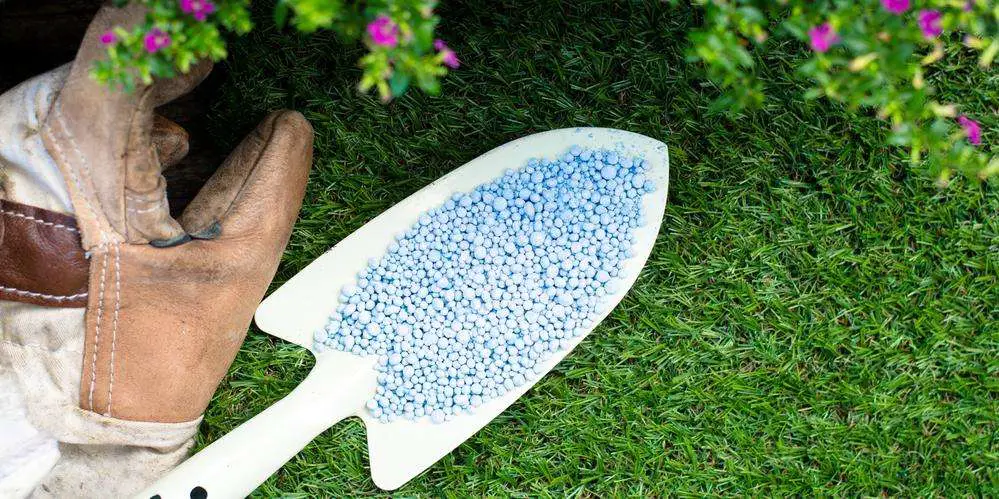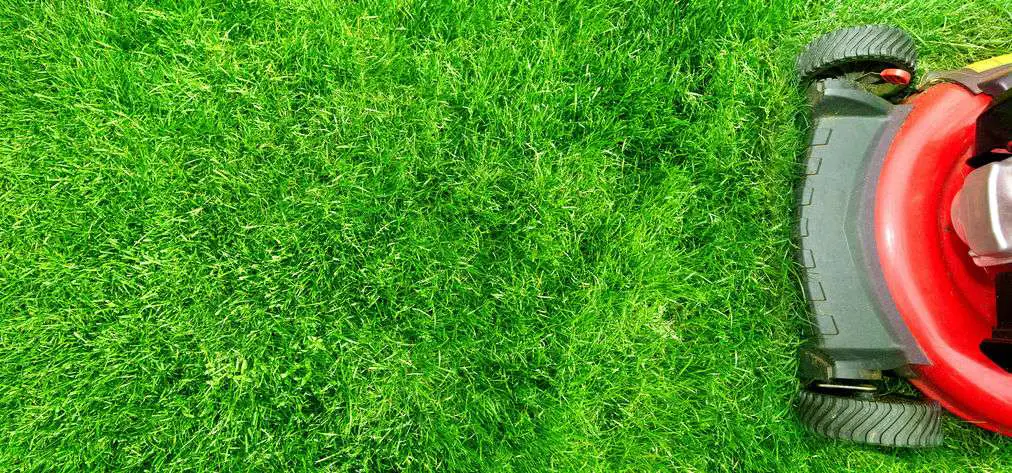Can You Fertilize Your Lawn Too Much
Its very easy to fertilize your lawn too much. Fertilizing your lawn with too much fertilizer in one application or not allowing enough time between applications, leads to three problems.
As long as you follow the instructions found on the packaging of the fertilizer, the three problems above can be easily avoided.
You Shouldnt Apply Most Fertilizers To Damp Grass
One reason why you shouldnt apply fertilizer in the morning is the fact that the dew on your lawn will make it too damp. With most fertilizers, you ought to make sure that your grass is dry before you apply fertilizer.
This way your fertilizer falls down to the turf below the grass blades, and doesnt stick to your grass .
There are some fertilizers on the market that you can use on wet grass, but with most youre better off fertilizing your lawn when its dry.
If you want to be able to fertilize your lawn when your grass is wet , you will have to use a fertilizer that can handle that kind of moisture.
I use Milorganite on my lawn, which is a slow-release organic fertilizer with iron. Its a product that does fine with a little bit of moisture, doesnt burn your lawn, and is safe for kids and pets. I consider it a staple fertilizer that you really cant get wrong, and recommend it to most homeowners who just want something to feed and green up their yard without any complicated math.
What If It Rains After I Fertilize My Lawn
Water can helpfertilizer fully absorb into the soil. Mild rain after you fertilize is nothing to worry about. However, if you have a lot of fertilizer in your soil, you may want to consider adding a small amount of water to your fertilizer.
This will help the fertilizer absorb more of the water, which will make it easier for the plant to absorb the nutrients. You can also add a little bit of compost to the mix to help with the absorption of nitrogen and phosphorous, as well as some organic matter to aid in the uptake of potassium, magnesium, calcium, and manganese.
Don’t Miss: How To Price Lawn Mowing Jobs
Understanding When To Apply Fertilizer
I recommend fertilizing your lawn four times annually with an organic, slow-release lawn fertilizer.
Your first application of fertilizer is best applied early in the season when grass has just started to grow.
This gives your grass a boost of nutrients early to help it take root and green up very quickly. When applied with a good pre-emergent herbicide , you allow your lawn to crowd out annual weeds every single year.
The rule of thumb is to apply your first batch of fertilizer when your soil hits 55-degrees Fahrenheit.
Usually, you can tell when the soil reaches temperature when lilacs bloom and grasses begin to sprout.
For more assurance, you can get a lawn thermometer at your hardware store or garden center, or you can buy one online .
Lawn Starter Fertilizer Vs Regular Fertilizer

Would you feed a newborn baby a slice of pizza? Of course you wouldnt. And obviously, thats a ridiculous question.
Because you know that babies have special needs. In order to grow and develop in the beginning, it is vital that they receive the nutrients they need from their mothers milk or baby formula.
Heres the thing, though. A lot of people do the equivalent of feeding a newborn a slice of pizza when they try to fertilize new grass.
How so?
They use regular fertilizer instead of starter fertilizer.
Both can provide plants with valuable nutrients, but they are not interchangeable. The nutrients they contain differ, and plants need each type at different stages of their life cycle.
Regular fertilizer contains a mix of nitrogen, potassium and phosphorus at a 1-2-1 ratio. Thats great for established plants, but not so wonderful for seedlings.
In fact, the main ingredient in most starter fertilizers is phosphorous, which makes grass seeds much more likely to germinate and sprout. Many also contain quick-release nitrogen to assist in germination and the development of the seed. In other words, they are specially formulated for seedlings.
So, when do you add starter fertilizer to your new turf?
Read Also: How To Get Rid Of Foxtails
The More You Know The More Your Grass Will Grow Here Are The Best Ways To Maximize Your Lawn Fertilization Schedule
Understanding when and how to fertilize your lawn is a major component to maintaining a healthy, lush yard. Fertilizers give your lawn a healthier root system while eating up unhealthy nutrients. With some simple steps, youll be on your way to having a lawn that is the envy of the neighborhood.
How Often Should You Put Epsom Salt On Your Lawn
Some homeowners like to use Epsom salt as a natural lawn fertilizer in the spring to facilitate lush green growth. Epsom salt contains magnesium, which is key to seed germination, chlorophyll production, and improving the uptake of nitrogen, phosphorus, and sulfur.
To try this method, add 2 tablespoons to each gallon of water used on the lawn. If you have a sprinkler system, lightly sprinkle the salt directly atop the grass and then allow the system to water it into the sod.
Don’t Miss: Trucomplete Lawn Service
My Take On Organic Fertilizers
Organic fertilizers are becoming more popular with lawn owners because of the idea that they are more environmentally friendly. Quality organic fertilizers will contain meal-based nutrients or some may contain poultry litter. A complete natural organic lawn food will have low NPK numbers, most always below 10. Its best to apply these fertilizers during the warmer growing months, from May through September, depending where you live. Organics help feed your lawn by stimulating microbial activity in your soil, creating a healthier medium in which your grass can grow.
They are safer to use and will not harm your lawn like some conventional fertilizers will, especially during the hot summer months. They work a bit slower, however, so youll need to be patient.
Youll also discover they are much more expensive. All that said, give them a try!
What Is The Importance Of Applying Fertilizer
The grass of the lawn gets extra nutrients from the fertilizer which prevent crabgrass and the grass grows thicker and greener. You must start around the perimeter of your lawn to make sure that you have laid the feed appropriately.
You may not know that soil loses many nutrients naturally over time. The nutrients are extremely important for the grass to grow deeper. Your lawn does not only look soothing and green but also lasts for a longer time.
You May Like: Scotts Summerguard Burned Lawn
How Soon You Can Fertilize After Seeding Your Lawn
Its not always after seeding that you should apply fertilizerthe best time to fertilize is right before or during the seeding process. Use a starter fertilizer with quick-release nitrogen since that will give the seeds a nutritional boost. When you make fertilizer a part of the seeding process, your grass will grow quicker and is more likely to end up healthy and lush.
Best Time To Fertilize Lawn
Fertilizing in the morning allows the soil to take in the most nutrients, soak in the morning dew and take advantage of cooler temperatures. Thats the best time. Do not apply fertilizer on an abnormally hot day, not even in the morning. Wait until the weather cools back down to a normal temperature.
You can mow anytime after fertilizing with a granular treatment. With a liquid treatment, wait a day or two.
Shutterstock
Read Also: Speedwell In Lawns
Don’t Bother Fertilizing Your Lawn Twice A Year
Fertilizing your yard too oftenor at the wrong timecan do more harm than good
A lush lawn can make your homes landscaping shine . But how do you maintain a beautiful and healthy yard year-round?
The answer is fertilizer.
Fertilizing provides the nitrogen that grass needs to better withstand pests and extreme heat and cold. But how frequently you fertilize your lawn can make the difference between a well-kept yard and one that looks worse for wear.
Overfertilizing can damage roots and cause scorching, leaving grass brown and patchy. Underfertilizing, though, can make grass less pest- and disease-resistant. And rules of thumbsuch as fertilizing twice a yeardont apply to every lawn, since weather conditions and grass cycles can vary depending on where you live.
The right time to apply fertilizer is when the grass is growing more roots than blades. In the Northeast and Northwest, thats usually in the fall. In the South and Southwest, its in the late spring. So in cooler climes, dont even think about it until Labor Day. And if you only fertilize once a year, do it in September using fall fertilizer.
How often you mow is also a factor in whether you have a lush lawn. Generally, you should let grass grow to 4½ inches and then cut it to 3 or 3½. Tall grass helps promote deep roots, making your lawn hardier and more resilient.
Bottom line: Listen to your lawn and apply fertilizer only when the grass calls for it.
Using A Broadcast Or Rotary Spreader

A broadcast or rotary spreader works well when you’re fertilizing larger lawn areas. Before filling the hopper, make sure it’s closed. It’s a good idea to fill it on a tarp, so you can easily gather any spilled fertilizer. Apply fertilizer around the perimeter of the lawn first, and then start to move back and forth across turf in an orderly pattern. Overlap application strips slightly to ensure that you cover the whole lawn evenly with fertilizer.
You May Like: Keep Rabbits Off Lawn
What Type Of Fertilizer To Use On Your Lawn
When picking fertilizers for your lawn, you have the option of liquid or granular, and synthetic or organic.
- Liquid: Fast and effective, but tough to spread and used mostly by professionals, may require the use of a backpack sprayer for large areas.
- Granular: Easiest to spread, the best option for home gardening.
- Synthetic: Made out of synthetic components, release their nutrition fast.
- Organic: Organic fertilizers for lawns are made from plants and animals, and are usually of the slow-release type. This means their effect will last longer.
Fertilize For The Health Of Your Lawn
Fertilizing is a great lawn care tactic to get ahead of the curve and give your plants that extra boost. Knowing just when to fertilize your lawn may seem tricky if you have never done it before or have switched your grass, Chorbie has the experts on duty to help with any landscaping needs or lawn care tasks, give us a call today!
Read Also: Thistledown Herbicide
Recommended Reading: Lawn Mowing Hiring
Does It Matter What Type Of Grass You Have
Yes. Grass is typically separated into two categories: warm-season grasses and cool-season grasses. If you have warm-season grass like Bermuda grass then youll want to fertilizer in early spring and again in late summer. If you have cool-season grass like Kentucky blue grass then youll want to fertilize in the fall and again in early summer.
How Often To Fertilize Lawn
Over-fertilizing is a thing. If once a year is right for your lawn, stick with that and dont get carried away. Fertilizer can be a valuable tool to keep a lawn healthy, dense and looking great, but it can also create environmental concerns if not used responsibly. Follow the label instructions on your fertilizer as each product has unique specifications and needs.
Don’t Miss: Can I Fertilize My Lawn Every 2 Weeks
Get Your Lawn Ready For Spring: Fertilize
UNIVERSITY PARK, Pa. After a fairly mild winter across the state, you can give your lawn a head start, head off the crabgrass, save yourself some money and maybe even impress the neighbors by following a few tips from a turfgrass specialist in Penn States College of Agricultural Sciences.
From a financial standpoint, fertilization does more to revitalize thin, weedy lawns than any other single management practice, says Peter Landschoot, professor of turfgrass science. With more user-friendly products on the market, lawn fertilization has never been easier provided you follow a few basic steps.
Soil Test. Soil tests tell consumers how much fertilizer and lime is needed. Test kits are available for a nominal fee at Penn State Cooperative Extension offices throughout the state. Soil tests can be taken and sent to Penn State any time of the year, but make sure you allow two to three weeks to receive your report.
Landschoot points out that some products contain slow-release nitrogen or water insoluble nitrogen.Its a good idea to have some slow-release nitrogen fertilizer in the bag, he says. This will provide longer-lasting green-up and reduce the chance of fertilizer burn. However, if all or most of the product is slow-release nitrogen, green-up of the lawn can be very slow. It may take weeks or even months to occur.
EDITORS: Contact Peter Landschoot at 863-1017 or by e-mail at .
Gary Abdullah Writer/editor Phone: 814-863-2708 E-mail:
What To Do After Your First Use Of Lawn Fertilizer
After you apply fertilizers, keep these tips in mind.
- Dont use the lawn for at least 24 hours. Keep pets and children away from the grass until its completely dry and the soil has absorbed the fertilizers.
- Dont mow for 48 hours. Avoid mowing the lawn for the first couple of days after fertilizing, because it can move the fertilizer around before its set.
You May Like: Ace Hardware Rabbit Repellent
Types Of Fertilizer For The Lawn
To make a fertilizer schedule for the first time you have to learn about which types of fertilizer you may prefer to use in your lawn. Here are some basic types of fertilizer that you can use for your lawn.
You can use both organic and inorganic fertilizer. Organics gives a slow but long-lasting result while inorganics are very fast and easy to apply. The fundamental ingredients in lawn fertilizers are nitrogen, phosphorous, and potassium, and they make up the N-P-K ratio listed on fertilizing products. Nitrogen gives the lawn its green color and vigorous growth. Phosphorous encourages healthy root growth, and potassium increases disease and weather resistance.
When To Fertilize Your Lawn

If you fertilize your lawn at the wrong time of year, you might as well not fertilize it at all. So, what is the right time of year? That depends on your grass types growing season. This guide goes into detail about when to fertilize your lawn, whether you have cool-season or warm-season grass.
You May Like: Husqvarna Hu800awdh (22) 190cc Honda High Wheel All-wheel Drive Self-propelled Lawn Mower
Lawn Fertilizer Schedule For Cool
Early spring: When the grass greens up after winter, usually late March or early April depending on the year and where you live
Early fall: The beginning of the second active growth season, usually early September
Late fall: At least 6 weeks before the first expected frost in your area, usually late October or early November depending on the year and where you live
Where Fertilizer Fits Into Your Grass Care Cycle
Like any other plant, grass makes its own food from sunlight and water. In contrast to the plant food that you might add to potted plants, fertilizer is really meant to improve the soil.
Whether youre using natural or synthetic, the reason you fertilize your lawn is to add micronutrients that improve the soil quality and help the grass grow.
When and Where Plant Get Their Essential Nutrients
Plants tend to grow in cycles, and grasses are no different. When your lawn is in a growing phase, the grass draws essential minerals like fertilizer, potassium, and phosphate from the soil. Although sunlight and water are the basic ingredients needed for grass growth, these minerals help produce structural and functional components that keep them healthy and strong.
When Fertilizer Comes In
Before or during the next growing cycle, which may not be until the next year, youll need to add another round of fertilizer to replenish the minerals that have been removed from the soil. Thats why many species of grasses dont need frequent fertilization.
Overfertilizing is wasting money on excessive minerals for your lawn and may risk damaging it, which well go over later. First, to decide exactly when and how often to fertilize your lawn, you need to identify what type of grass it has.
Recommended Reading: Small Rider Mower
What To Do After Youve Fertilized Your Lawn
After youve fertilized your lawn, youll need to observe its growth to make sure youve done the job properly and take proper steps, depending on what you find.
- Know what minerals you need to add. Make sure you have essential tools on hand like soil mineral and pH test kits, which will tell you what minerals are lacking and if the pH is too high or low.
- Another late-season application. Based on its growth, you may need to add more fertilizer later in the season, especially if youre dealing with cool-season grasses in the fall.
- Retest after heavy rain. While following fertilizer with water will protect your lawn and improve your soil quality, too much water is not a good thing.
If theres heavy rain within a day or two of fertilizing your lawn, make sure your lawn hasnt lost everything you just added. Retest and apply fertilizer one more time, if needed.
